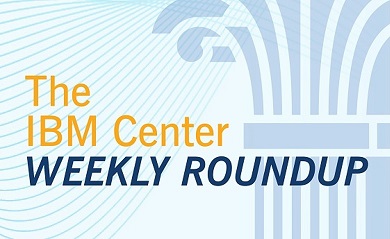
Weekly Roundup: September 27-October 1, 2021

Working Together as a Federal IT Enterprise to Deliver for the American People. In a new blog post, Federal CIO Clare Martorana discusses how the pandemic forced us to re-evaluate the way we operate across government and ask how we can serve our citizens faster and more securely. When our citizens need something from the federal government, they don’t think about an agency’s name or organizational chart; instead, they focus on the service, benefit, or information they need – and try their best to get it.
5 ways to meet OMB’s cybersecurity deadline for critical software. From ransomware attacks on operational technology (OT) systems to data theft targeting enterprise email systems, critical software vulnerabilities are constantly being exploited by sophisticated cyber threats. Agencies can take several actions right now to both meet this immediate milestone and lay a strong foundation for future requirements like developing and submitting an implementation plan in the next 12 months, meeting National Institute of Standards and Technology guidance, and strengthening overall cyber protection. Five of these actions follow.
Technology Modernization Fund support awarded to 7 new agency IT projects. The Technology Modernization Fund Board on Thursday announced seven new projects in its first round of awards for agency IT modernization since the fund received a $1 billion infusion as part of the American Rescue Plan. The Office of Personnel Management, General Services Administration and the departments of Homeland Security and Education will receive support for new proposals through the distribution, which in total hands out $311 million to agencies for projects largely focused on addressing cybersecurity, data privacy concerns and the move to zero trust. The board did not reveal the repayment terms for each project.
Addressing Fragmentation, Overlap, and Duplication: Progress in Enhancing Government Effectiveness and Achieving Hundreds of Billions of Dollars in Financial Benefits. The federal government continues to respond to and recover from significant public health and economic challenges battling the COVID-19 pandemic. This report discusses the progress Congress and executive branch agencies have made in addressing actions GAO identified in its 2011 to 2021 reports. Additionally, the report provides examples of open actions where further steps by Congress and executive branch agencies could yield significant financial and non-financial benefits.
The Failure of Government's Post-Covid Imagination. The 9/11 Commission Report had a jarring conclusion: The core problems of the terror attacks stemmed from a “failure of imagination” in anticipating the risks the nation faced. Now, 20 years later, we’re falling into another failure of imagination, this time about the future of work in government. The “future of work” has received a great deal of attention, but most of the discussion in government has centered on getting feds back behind their desks. However, the issues at stake are far larger. Here are 12 lessons to guide the way.
4 steps to identify how you view your leadership. Leaders of any title or level should reflect on what their values are and how those values affect their leadership approach, writes Ken Blanchard, who offers a four-step process. "A leadership point of view is a very personal statement that requires reflection and vulnerability," he writes. Blanchard LeaderChat
3 key ingredients for a culture that attracts talent. Companies will retain more of their top talent by creating a culture that respects employees as people as well as for what they accomplish, along with leaders who model, coach and reward progress, says S. Chris Edmonds in this blog post and video. This is especially important in a time where millions of people are quitting jobs and pandemic-induced emotional stress is high. SmartBrief/Leadership
Leadership may look easy, but don't be fooled. Leadership would be easier if you could learn everything you need to know from a book, but as Wally Bock writes, the reality is that leadership involves constant learning, transparency and vulnerability to enjoy its rewards. "If you love the work and do it well, leadership work is a marvelous way to spend the days of your life," he writes. Three Star Leadership
What do you mean by "flexibility"? Companies need to define what "flexible" work means while creating clear roles for the organization, teams and employees in determining the specifics, write organizational researchers Ellen Ernst Kossek, Patricia Gettings and Kaumudi Misra. Some form of flexibility should be offered to every employee rather than what many companies do, which is use flexibility as a way to penalize some workers and reward others. Harvard Business Review (tiered subscription model)
Let's rethink risk. Many people tend to think of risk as temporary, something to be squared away, when we really need a mindset that views risk as "simply an environmental element that must be considered in applying and employing what's essential," writes Larry Robertson. He offers four dimensions of risk, exploring how they're typically viewed and how we might revise our thinking for long-term success. SmartBrief/Leadership
* * * *
Next Week on The Business of Government Hour: A Conversation with Jamie Holcombe, Chief Information Officer, U.S. Patent and Trademark Office (USPTO). What is the IT strategy for the U.S. Patent and Trademark Office (PTO)? How is it using technology and innovation to change the way it does business? Join host Michael Keegan as he explores these questions and more with Jamie Holcombe, Chief Information Officer at USPTO.
Broadcast Schedule: The show airs Monday at 11 a.m., and Friday at 1 p.m. on Federal News Network 1500AM WFED





